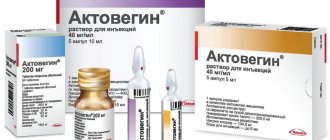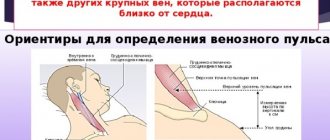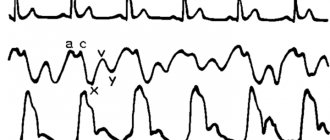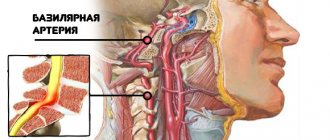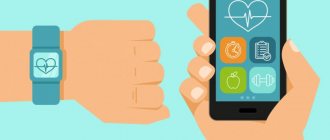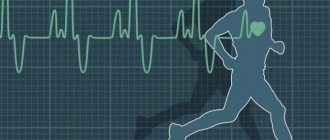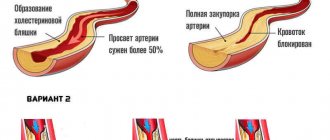Pulse fluctuations have physiological and pathological causes. In the first case, an increase in heart rate can be triggered by emotional and physical stress, drinking large amounts of coffee or energy drinks, a hangover, general fatigue, and sleepless nights.
Pathological causes are more extensive - from cancer to infectious processes with a latent course. Therefore, you need to consult a doctor for diagnosis if pulse surges occur regularly and other symptoms such as dizziness, increased blood pressure, and hand tremors are present.
If the pulse fluctuates between 50-110 beats per minute during the day, then this is a clear confirmation of tachycardia of pathological origin, and this condition is fraught with strokes and heart attacks.
Pulse jumps: causes in adults
The most common causes of pulse surges in adults are physiological factors:
- excessive stress on the body associated with work, inadequate night rest;
- overeating, especially when fatty foods and any “heavy” foods such as kebabs and salted fish were consumed;
- psycho-emotional disorders, frequent experiences;
- excessive physical activity.
In addition, fluctuations in heart rate may be present in those people who drink energy drinks, drink large quantities of coffee and strong tea. Uneven heart rate is characteristic of hangover syndrome.
All these conditions are not dangerous and do not require any specific treatment. But if the pulse jumps from 50 to 110 beats per minute, and this happens several times during the day, there are symptoms of a clear deterioration in health (nausea, headache, trembling of the upper limbs, and so on), then you need to contact a cardiologist for diagnosis - these are signs tachycardia, which can be caused by various pathologies.
How does the heart rate depend on the results of blood pressure measurements?
Both pulse and blood pressure (BP) are important indicators of overall health. It is these values that are determined in the patient during the initial visit to the therapist.
They help to identify the degree of dysfunction of the cardiovascular system and the level of quality of cellular nutrition.
If the heart rhythm and its contractility are disturbed, the load on the arteries and vessels increases, as a result of which heart diseases subsequently develop and the general condition of the patient worsens.
Bradycardia often occurs due to high blood pressure
Bradycardia is often observed in people prone to hypertension. You should find out from a specialist how to raise your pulse with high blood pressure. You should not take special medications without the recommendation of a therapist.
The concept of pulse and blood pressure
Blood pressure shows the degree of blood pressure in the arterial system. To determine the state of functioning of the body, two values are important:
- Systolic. Measured at maximum contraction of the heart muscle.
- Diastolic. Shows pressure during the period of maximum relaxation of the myocardium.
With high blood pressure values, determined using a special device - a tonometer, a person must take certain measures, since the risk of strokes and heart attacks, the appearance of chronic heart dysfunction and other diseases of the vascular system significantly increases.
The normal blood pressure is 120/80
The optimal blood pressure reading is considered to be 120/80. When they increase above 140/90, observed over a long period, the doctor diagnoses “hypertension”.
Do not forget that a slight increase in values during physical activity is the norm and is considered an acceptable reaction of the body. It is very important to measure your blood pressure at rest.
It is important to remember that blood pressure levels may increase after drinking caffeinated drinks and smoking.
The flow of blood through the arteries is uneven. Its movement occurs in impulses, which are provided by contractions of the heart muscle. The pulse can be determined by pressing the thumb against the radial artery located in the wrist. Modern tonometers show all the necessary values at once.
A weak pulse and low blood pressure can indicate various diseases associated with both blood disease and dysfunction of certain organs.
Such indicators are often observed with reduced thyroid function. Some people have normal blood pressure but exhibit bradycardia.
The question of how to raise the pulse without raising blood pressure is decided by a specialist after a complete examination of the patient.
Pulse and blood pressure are inextricably linked
Relationship between blood pressure and heart rate
Heart rate (HR) should always be measured at rest. This indicator, as well as blood pressure values, normally increases during physical activity.
The relationship between pulse and blood pressure is explained as follows: with an increase in blood pressure, intracranial pressure increases, which leads to activation of the vagus nerve and provoking bradycardia.
Pulse for hypertension
Hypertension is rarely accompanied by bradycardia, a state of the body in which the heart rate does not exceed 50 beats/min. The most common causes of a low pulse are pathologies such as:
- cardiosclerosis and myocarditis;
- vegetative-vascular dystonia;
- infectious diseases;
- dysfunction in the endocrine system;
- hypovitaminosis;
- blood diseases.
Low heart rate may be caused by cardiosclerosis
Heart problems and bradycardia can be caused by long-term use of certain medications, atherosclerosis, and the presence of scars after heart attacks.
Prolonged stress conditions accompanied by nervous breakdowns and intracranial hypertension also play a certain role in reducing heart rate. Physiological reasons can also influence the weakening of the pulse.
Thus, bradycardia can appear when a person moves from heat to cold.
In cases where such phenomena occur rarely and are accompanied by mild symptoms, there is no need to worry. But with severe bradycardia, in which the heart rate is less than 40 beats/min, starvation of brain cells occurs, which is dangerous for the development of irreversible changes in the vascular system. A decrease in heart rate due to hypertension in older people sometimes leads to a heart attack or stroke.
It is important to know how to increase your heart rate without increasing your blood pressure. Most often, specialists prescribe medications belonging to the group of ACE inhibitors to hypertensive patients with symptoms of bradycardia.
Such drugs act smoothly and sparingly. Strong antihypertensive drugs are contraindicated in this case, as they can cause loss of consciousness and respiratory arrest.
Beta blockers are also dangerous for these patients.
A common symptom of high blood pressure is tachycardia.
Hypertensive patients often suffer from tachycardia. This condition is also dangerous because the load on the heart increases significantly.
The reasons for a sharp increase in blood pressure and pulse most often lie in excessive physical exertion, disruptions in the endocrine system, and serious stress.
In this case, general weakness, severe headaches, redness of the skin, dizziness, and difficulty breathing may occur. If this condition occurs, you should seek medical help.
If you are prone to bradycardia and hypertension, the patient should definitely ask the therapist how to increase the pulse without increasing the blood pressure.
Pulse with hypotension
There is no need to worry if blood pressure is slightly reduced and heart rate is normal. As a rule, a person with this condition most often feels stable and does not even realize the presence of hypotension.
With low blood pressure and bradycardia, nausea and weakness may occur
In some cases, low blood pressure is diagnosed due to bradycardia. In this case, the patient complains of dizziness, nausea, weakness, fatigue, depression, and chills. The doctor will definitely tell you what to do if you have low blood pressure and a low pulse after examination and a full examination.
Hypotension is often accompanied by tachycardia. Typically, patients note the appearance of nausea, anxiety, migraines, and sweating. Pain in the chest area may occur. To identify the cause of increased heart rate and hypotension, you should undergo an examination.
Sometimes patients with vegetative-vascular dystonia experience sudden changes in blood pressure. In this case, it is necessary to observe what the pulse is like at high blood pressure.
The causes of low blood pressure and low pulse are most often the same as with hypotension accompanied by tachycardia:
- diseases of endocrine organs;
Anemia may be one of the causes of hypotension
- diseases of the nervous system;
- respiratory type of arrhythmia;
- anemia;
- vegetative-vascular dystonia;
- serious blood loss;
- infectious diseases;
- heart damage.
If you are prone to low blood pressure, it is recommended to take courses of Eleutherococcus tinctures, drink green tea and coffee daily. If the cause of this condition is identified, the patient is prescribed medication.
What is arrhythmia
Blood pressure and pulse may decrease or increase in patients with cardiac arrhythmia, in which its rhythm and regularity of contractions are disrupted. A similar condition is detected in patients with heart attacks, dysfunctions of the nervous system, and intoxications. Arrhythmia does not always occur in sick people.
Heart rhythm disturbances can occur with severe fatigue or excessive physical exertion. However, the symptoms of this phenomenon often go unnoticed. Arrhythmia is not always associated with disorders in the heart itself.
It can occur with hyperthyroidism (thyroid disease) and some other diseases.
Blood pressure problems are often observed in patients with arrhythmia
Irregular heart rhythm is accompanied by a rare, rapid or irregular pulse. With reduced thyroid function, increased intracranial pressure, and certain types of infections, sinus bradycardia may be observed. With atherosclerosis and intoxication conditions, premature heart contractions (extrasystoles) may occur.
Arrhythmia accompanied by ventricular tachycardia occurs not only in older people. This phenomenon is sometimes observed at a young age, when the right ventricle of the heart undergoes structural changes.
The danger of arrhythmia lies in the increased likelihood of its transformation into atrial fibrillation, which is more dangerous for the patient. In this case, contractions of the ventricles occur defectively, which leads to disruption of the blood supply to the brain and other body systems.
See your doctor so he can confirm that you have an arrhythmia.
If signs of arrhythmia appear, you should consult a doctor. You can monitor and determine the dependence of pulse on pressure using automatic tonometer devices. All patients suffering from blood pressure disorders must have such devices for home use.
Blood pressure and pulse in children
Blood pressure levels and heart rate in children of different ages vary significantly. If in one-year-old babies blood pressure should not exceed 90/50, then in children over two years old it is normally 100/60. In adolescents, blood pressure values reach the adult norm – 120/80.
Heart rate also changes depending on age. Thus, newborns have a pulse from 120 to 160 beats/min. In two-year-old children, the indicator should not exceed 150. Normally, in children 7-8 years old, the heart rate is on average 97, in adolescents - 70 beats/min.
Children should also have their blood pressure and pulse checked.
Experts advise measuring blood pressure and pulse in children regularly. If deviations from normal values are detected, you should definitely show the child to the pediatrician. In children, it is easiest to determine the pulse in the cervical area in the area of the carotid artery. In older children, you can calculate your heart rate by placing your thumb on your wrist.
There is no need to worry if you notice an increase or decrease in heart rate once.
Observation must be carried out within a week. It is important to remember that the reliability of the data will be higher if the child is at rest. You should not determine your heart rate after eating, in the cold, in a hot room, or after physical activity.
Tachycardia, as well as increased blood pressure in children, occurs with a viral infection, emotional overload, anemia, malfunction of the endocrine organs, respiratory system, and impaired cardiac function. After treatment, such disorders usually disappear.
If your child complains of dizziness and weakness, be sure to show him or her to the doctor.
It is necessary to measure blood pressure and heart rate for some time if the child develops weakness, fatigue, dizziness, or pale skin.
You should undergo an examination if your baby shows signs of bradycardia or hypotension. Such signs can be observed with hypothyroidism, anemia, infectious disease, and parasitic infestations.
It is important to remember that the danger of chronic bradycardia lies in the development of heart failure.
You can learn how blood pressure and pulse are related from this video:
Source: https://serdcedoc.com/davlenie/pokazatel-pulsa-i-davleniya.html
Why does a teenager's pulse fluctuate?
In adolescence, the pulse fluctuates almost every day, and not only against the background of physical activity and any emotional experiences, often the causes of a rapid pulse are:
- active growth of the body - puberty is characterized by uneven growth of muscles, bones and blood vessels;
- hormonal changes in the body - too active production of hormones necessarily affects the heart rate, and the vessels are simply not able to cope with the sudden surge of blood;
- strain on the organs of vision – we are talking about long periods of time at the computer or on the phone.
If pulse fluctuations do not occur regularly, the frequency quickly normalizes, there are no chest pains or headaches, nausea, tremors (trembling) of the limbs, decrease/increase in body temperature, then parents and the teenager himself do not have to worry - this is how the period of active maturation of the body manifests itself.
Video on the topic
Video explaining the relationship between pulse and pressure:
So, why do blood pressure and pulse rise sharply? The reasons may lie in the body’s normal response to physical activity, or in the development or presence of a disease. If your pulse and blood pressure fluctuate, the best solution would be to consult a doctor in order to rule out the possibility of pathologies in any case or to detect them in time.
The information on the MyMedNews.ru website is for reference and general information, collected from publicly available sources and cannot serve as a basis for making a decision on the use of medications in the course of treatment.
MyMedNews.ru
And we also have
Excess calcium in the body leads to death
A sharp jump in blood pressure and pulse: reasons
If, simultaneously with a surge in blood pressure, an increase in blood pressure occurs, this is most often a sign of tachycardia. It may be present on a daily basis or appear from time to time; in any case, consultation with a cardiologist is required, because this condition is provoked by pathologies:
- cervical osteochondrosis;
- low level of hemoglobin in the blood (anemia);
- lack of potassium and magnesium in the body;
- cardiac ischemia;
- disorders of the thyroid gland.
It is interesting that the listed pathologies in the initial stage of their development are practically asymptomatic and surges in pressure/pulse are the only sign.
Tips and Recipes
Physical examination data indicating the secondary nature of arterial hypertension (AH) and organ pathology.
— Symptoms of the disease and Itsenko-Cushing syndrome.
- Neurofibromatosis of the skin (may indicate pheochromocytoma).
— Detection of enlarged kidneys by palpation (polycystic kidney disease, space-occupying formations).
— Auscultation of the abdominal area: murmurs over the area of the abdominal aorta, renal arteries (renal artery stenosis - vasorenal arterial hypertension (AH)).
— Auscultation of the heart-chest area (coarctation of the aorta, aortic diseases).
— Weakened or delayed pulse in the femoral artery and reduced blood pressure (BP) in the femoral artery (coarctation of the aorta, nonspecific aortoarteritis).
— Brain: auscultation of murmurs over the carotid arteries. Motor or sensory disorders.
— Retina: changes in the fundus.
— Heart: increased apical impulse, cardiac arrhythmias, assessment of manifestations of heart failure (wheezing in the lungs, presence of peripheral edema, determination of liver size).
- Peripheral arteries: absence, weakening or asymmetry of the pulse, coldness of the extremities, symptoms of skin ischemia.
— general blood and urine analysis;
- plasma glucose content (on an empty stomach);
- blood serum content of total cholesterol, high-density lipoproteins, triglycerides, creatinine, uric acid, potassium;
- chest x-ray;
- Ultrasound examination (ultrasound) of the abdominal organs.
Additional recommended studies
Rice. 1. Method of measuring pulse in various arteries: 1 - temporal; 2 - shoulder; 3 - dorsal artery of the foot; 4 - radial; 5 - posterior tibial; 6 - femoral; 7 - popliteal. Pulse - fluctuations in the walls of blood vessels associated with changes in their blood supply during the cardiac cycle.
There are arterial, venous and capillary pulses. The study of the arterial pulse provides important information about the work of the heart, the state of blood circulation and the properties of the arteries.
The main method of studying the pulse is palpation of the arteries. To palpate the radial artery, the hand of the subject is loosely clasped in the area of the wrist joint so that the thumb is located on the back of the forearm, and the remaining fingers are on the anterior surface of the radius, where the pulsating radial artery is felt under the skin.
The pulse is felt simultaneously in both hands, since sometimes it is expressed differently on the right and left hands (due to vascular abnormalities, compression or blockage of the subclavian or brachial artery). In addition to the radial artery, the pulse is examined in the carotid, femoral, temporal arteries, arteries of the feet, etc. An objective characteristic of the pulse is given by its graphical registration (see.
When examining the pulse, its frequency, rhythm, filling, tension and speed are determined.
Rice. 2. Graphic recording of pulse: 1 - normal; 2—arrhythmic (a—c—various types); 3 - intermittent; 4 - large and fast (a), small and slow (b); 5 - dicrotic. In healthy adults, the pulse rate corresponds to the heart rate and is 60-80 per minute.
When the heart rate increases (see Tachycardia) or decreases (see Bradycardia), the pulse rate changes accordingly, and the pulse is called frequent or rare. When body temperature increases by 1°, the pulse rate increases by 8-10 beats per minute. Sometimes the number of pulse beats is less than the number of heart beats (pulse deficiency).
This is explained by the fact that during very weak or premature contractions of the heart, so little blood enters the aorta that the pulse wave does not reach the peripheral arteries. The higher the pulse deficit, the more adversely it affects blood circulation.
To determine the pulse rate, count it for 30 seconds. and the result obtained is multiplied by two. If the heart rhythm is disturbed, the pulse is counted for 1 minute. In a healthy person, the pulse is rhythmic, that is, pulse waves follow one another at regular intervals. In case of heart rhythm disorders (see Cardiac Arrhythmias), pulse waves usually follow at irregular intervals, and the pulse becomes arrhythmic.
The filling of the pulse depends on the amount of blood ejected during systole into the arterial system and on the distensibility of the arterial wall. Normally, the pulse wave is well felt - a full pulse. If less blood enters the arterial system than normal, the pulse wave decreases and the pulse becomes small.
In case of severe blood loss, shock, or collapse, pulse waves can be barely palpable; such a pulse is called threadlike.
A decrease in pulse filling is also observed in diseases that lead to hardening of the arterial walls or narrowing of their lumen (atherosclerosis).
With severe damage to the heart muscle, an alternation of large and small pulse waves is observed - intermittent pulse.
Pulse voltage is related to the height of blood pressure. With hypertension, it takes some force to compress the artery and stop it from pulsating—a hard, or tense, pulse. With low blood pressure, the artery is easily compressed, the pulse disappears with little effort and is called soft.
The pulse rate depends on the pressure fluctuations in the arterial system during systole and diastole.
If the pressure in the aorta rises rapidly during systole and falls rapidly during diastole, then rapid expansion and collapse of the arterial wall will be observed. Such a pulse is called fast, but at the same time it can be large. Most often, a fast and large pulse is observed with aortic valve insufficiency.
The slow increase in pressure in the aorta during systole and its slow decrease in diastole causes a slow expansion and slow collapse of the arterial wall - a slow pulse; at the same time it can be small. Such a pulse appears when the aortic mouth narrows due to difficulty in expelling blood from the left ventricle.
Sometimes after the main pulse wave a second, smaller wave appears. This phenomenon is called pulse dicrotism. It is associated with changes in arterial wall tension.
Dicrotic pulse occurs with fever and some infectious diseases. When palpating the arteries, not only the properties of the pulse are examined, but also the condition of the vascular wall. Thus, with a significant deposition of calcium salts into the wall of the vessel, the artery is palpated in the form of a dense, convoluted, rough tube.
Pulse rate in children in 1 minute Age Pulse rate Newborn6 months1 year2 years3 years4 years5 years6 years7 years8 years9 years10 years11 years12 years13 years14 years15 years 120—140130—135120—125110—115105—110100—10598—10090—9585—9080—8580 —8578 —8578—8475—8272—8072—7870—76 The pulse in children is more frequent than in adults. This is explained not only by the lesser influence of the vagus nerve, but also by a more intense metabolism.
With age, the heart rate gradually decreases.
Girls at all ages have a higher heart rate than boys.
Screaming, restlessness, and muscle movements cause a significant increase in heart rate in children. In addition, in childhood there is a known unevenness of pulse periods associated with breathing (respiratory arrhythmia).
Pulse (from Latin pulsus - push) - rhythmic, jerk-like vibrations of the walls of blood vessels, resulting from the release of blood from the heart into the arterial system.
Doctors of antiquity (India, Greece, the Arab East) paid great attention to the study of the pulse, giving it decisive diagnostic importance. The doctrine of the pulse received a scientific basis after the discovery of blood circulation by W. Harwey.
The invention of the sphygmograph and especially the introduction of modern methods of pulse recording (arteriopiesography, high-speed electrosphygmography, etc.) significantly deepened knowledge in this area.
With each systole of the heart, a certain amount of blood is rapidly ejected into the aorta, stretching the initial part of the elastic aorta and increasing the pressure in it.
This change in pressure propagates in the form of a wave along the aorta and its branches to the arterioles, where normally, due to their muscular resistance, the pulse wave stops. The pulse wave propagates at a speed of 4 to 15 m/sec, and the stretching and elongation of the arterial wall it causes constitutes the arterial pulse.
There are central arterial pulses (aorta, carotid and subclavian arteries) and peripheral (femoral, radial, temporal, dorsal arteries of the foot, etc.). The difference between these two forms of pulse is revealed by its graphical registration using the sphygmography method (see). On the pulse curve - sphygmogram - there are ascending (anacrotic), descending (catacrotic) parts and a dicrotic wave (dicrotic).
In case of anomalies in the location of the artery, the presence of bandages on the arms or massive edema, a pulse examination is carried out on other arteries accessible to palpation. The pulse at the radial artery lags behind the systole of the heart by approximately 0.2 seconds. Pulse examination on the radial artery must be carried out on both arms;
In this case, the thumb should be placed on the ulnar side, and the index, middle and ring fingers should be placed on the radial side, directly on the radial artery. Normally, you get the feeling of a soft, thin, smooth and elastic tube pulsating under your fingers.
If, when comparing the pulse on the left and right hands, a different value is detected or a delay in the pulse on one hand compared to the other, then such a pulse is called different (pulsus differens). It is observed most often with unilateral anomalies in the location of blood vessels, compression by tumors or enlarged lymph nodes.
What causes your heart rate to fluctuate at rest?
If your heart rate fluctuates at rest, you need to pay attention to the following factors:
- age of the person - in the elderly, an increase in heart rate is considered normal if it is not accompanied by pain and shortness of breath;
- ambient temperature - if it is high, then vasodilation will certainly lead to an increase in heart rate, thus the body simply cools down;
- lack of fluid in the body - banal dehydration makes the blood thick, reduces the amount of plasma, and the heart has to work with redoubled force to maintain blood circulation;
- stressful situations - even at rest a person is able to worry, remember, look for solutions to problems and an increase in heart rate against the background of stress is also possible;
- excessive physical activity - if a person is specifically involved in sports and his pulse increases at rest, then he needs to either reduce the time of training and its intensity, or increase the rest time between them;
- emotional state - even slight excitement automatically leads to an increase in heart rate.
The listed factors relate to the physiological causes of pulse fluctuations at rest; they are quite easy to correct.
But if, against the background of the main symptom, a person is bothered by headaches, a feeling of pressure in the chest (the anatomical location of the heart), periodic increases in blood pressure, and dizziness, then it is worthwhile to undergo examination by a cardiologist. It is possible that pathologies such as microinfarction, heart failure, malignant neoplasms, infectious or inflammatory processes will be diagnosed - they may occur for some time without pronounced characteristic symptoms.
Treatment
The action of some antihypertensive drugs is aimed at eliminating symptoms, while others are aimed at combating diseases that cause rapid heart function. To influence the problem in a comprehensive manner, you need to select medications wisely, and only a doctor can tell you how to reduce blood pressure and heart rate.
Medication
Among the most effective drugs that are safe for all groups of patients, cardiologists note:
Valerian is a natural medicine produced from the root of the plant that provides a calming effect;- Persen is a sedative, has a positive effect on the nervous system;
- motherwort tincture is a strong sedative that affects heart rate;
- Phenobarbital is a sleeping pill that normalizes sleep and stabilizes the functioning of the nervous system;
- Relanium is a heart-slowing antidepressant.
The above medications only affect the heart rate; they do not have a hypotensive effect.
That is why it is important to use them in combination with drugs from the following groups:
diuretics - Hypothiazide, Furosemide;- ACE inhibitors - Renipril, Diroton;
- sartans – Lozap, Nortivan, Diovan;
- calcium channel blockers – Verapamil, Felodip;
- alpha and beta blockers - Cardura, Tonocardin, Lokren, Binelol, Concor.
If there are more painful sensations in the chest or head, analgesics can be prescribed.
Convulsions are relieved with anticonvulsants and muscle relaxants.
Swelling in the legs is a sign of heart failure and loop diuretics are suitable to relieve it.
Folk remedies
It is not only possible, but also necessary to lower the heart rate with high blood pressure using folk remedies. This is the safest way to restore normal heart function without reducing the functionality of other organs and systems. A decoction of medicinal herbs, such as:
- lemon balm;
- motherwort;
- Dill seeds;
- mint;
- valerian;
- hop cones;
- calendula.
You can use herbs alone or in combination. To prepare the decoction, you need to pour boiling water over the dry raw materials and leave in a thermos for half an hour. Drink half a glass three times a day.
Before choosing what to drink for hypertension and tachycardia, remember whether you have an individual intolerance to these plants.
Garlic decoction will help improve the quality of blood, as well as relieve inflammation in blood vessels.
A few cloves of garlic are crushed to a paste and pour in 500 ml of milk. Drink 50 g three times a day. A decoction of willow bark, chicory root and aloe juice has antihypertensive properties. All ingredients are mixed together and brewed for 5 minutes. Drink as tea twice a day. The product removes excess fluid from the body, increases vascular tone, strengthens the heart muscle and normalizes the functioning of the central nervous system.
It is important to note that alternative treatment methods should be used exclusively as an addition to the main drug therapy regimen. It is unacceptable to treat such serious pathologies as hypertension and tachycardia with herbs.
General Tips
People who have an elevated pulse combined with hypertension are recommended to replace hot baths with a contrast shower. Such procedures tone blood vessels and normalize blood circulation, and also give a boost of energy for the whole day,
Normalizing weight and controlling blood sugar will help reduce the intensity of myocardial work. Hypertension is a disease that dictates lifestyle. A person with critical heart rate and blood pressure is constantly forced to diet and take antihypertensive drugs.
A very good effect is achieved in treatment if you combine synthetic drugs with massage and gymnastics. Impact on biologically active points will strengthen the body's resistance to stress, and will also develop muscles that will help push blood to vital organs. Light physical exercise will eliminate congestion in blood vessels and improve blood circulation.
Blood pressure and pulse jump: reasons
If the pulse periodically quickens or slows down against the background of a decrease/increase in blood pressure, then the causes of this condition may be:
- myocarditis;
- malignant neoplasms;
- infectious diseases;
- hyperthyroidism (thyroid disease);
- heart defects;
- pathological changes in the upper chamber of the heart;
- obesity 2-3 degrees;
- pulmonary or heart failure;
- benign tumors;
- cardiac ischemia.
The listed conditions are exclusively pathological in nature; they require long-term and targeted treatment.
3) Pulse properties:
A) Frequency
(number of pulse rises per minute.
Normal: 60-80/min; in women and children - more often; more often when inhaling, less often when exhaling. The student determines the pulse rate on one of the radial arteries by counting the number of pulse oscillations (waves) per minute.
Frequent pulse (p. frequens) with tachycardia, heart failure,
with BP (bleeding, shock, temperature, intoxication); thyrotoxicosis, heart defects.
Rare pulse (p. rarus) with bradycardia, myxedema, poisoning, uremia, jaundice, stroke, aortic stenosis.
B) Rhythm
(reflection of contractions of the left ventricle) Normally, pulse waves follow each other at regular intervals, p.Regularis (regular pulse). If pulse waves follow one another at irregular intervals, then they speak of p.Irregularis (irregular pulse).
In pathology it occurs:
-p. irregularis: - (irregular): with extrasystoles, atrial fibrillation
arrhythmias, blockades, paroxysmal tachycardias, irregular
-p.intemittens: alternating, intermittent pulse;
-p. paradoxus (after inhalation, weak or disappears mediastinal tumor, pericarditis, adhesions, atrial flutter.
B) Filling:
By squeezing and releasing the artery, the student determines its filling with blood;
In pathology it occurs:
-full pulse (p. plenus) with arterial hypertension;
- empty pulse (p. vacuus) with blood loss, shock;
-high pulse (p. altus) with arterial hypertension and aortic insufficiency.
D) Voltage
(weak, medium, strong). By squeezing and releasing the artery, the student pays attention to the force with which it is possible to squeeze the artery and stop the pulsation in it. Normally, this force is small - p.Mollis.
In pathology it occurs:
-hard (p. durus) for hypertension;
-soft (p. mollis) with hypotension.
E) Magnitude
(filling + tension): When feeling the pulse, the student pays attention to the height or amplitude of fluctuations of the pulse waves. Normally, pulse waves are of medium size (amplitude).
In pathology it occurs:
-large pulse (p. Magnus, p. altus) with high waves
observed in hypertension;
-small pulse (p. parvus) with blood loss, shock;
- thread-like (p. filiformis) with blood loss, shock.
G) Speed
(form) - Feeling the pulse, the student must estimate the rate of rise and duration of the pulse wave, which depend on:
a) degree of expansion of capillaries;
b) blood pressure;
d) pulse wave.
Normally, the pulse wave does not have a steep rise and fall with an average duration.
In pathology there are:
Rapid pulse (p.celer) with psychogenic excitement, with hyperthyroidism, with aortic valve insufficiency;
Slow pulse (p. tardus) with stenosis of the aortic mouth;
Dicrotic pulse (p. dicroticus) with fever and infections, with
decreased vascular tone;
Anacrotic pulse (p.anacroticus) with arterial hypertension.
Typical sites of auscultation of arterial vessels are shown in circles in Fig. 3.
Detection of systolic murmur (without squeezing the artery with a stethoscope)
above the artery indicates its narrowing.
When determining a systolic murmur over the carotid artery or subclavian artery, auscultation of the auscultation point of the aorta is required, since the murmur may be conductive from the orifice of the aorta.
In case of aortic valve insufficiency above the femoral artery, a double Traube sound (a sharp pressure drop in systole and diastole) or a double Durosier murmur may be observed when the artery is compressed with a stethoscope (stenotic murmur in systole and possibly the noise of retrograde blood flow in diastole)
With renal artery stenosis, systolic murmur can be detected in the mesogastrium or on some side of the spine at the level of the 12th thoracic - 1st lumbar vertebrae.
INDIRECT MEASUREMENT OF BLOOD PRESSURE.
1. Starting position: the patient sits at a table or lies on his back in bed. Both shoulders are freed from clothing. If measurements are required on the femoral artery, both thighs are exposed. The doctor is located to the right of the patient and in front of him. When measuring pressure on the brachial artery, a cuff from the Riva-Roci device or a spring pressure gauge is placed on the exposed shoulder. The cuff should fit snugly, allowing only one finger to pass through. The edge of the cuff with the rubber tube should face down and be located 2–3 cm above the cubital fossa. After securing the cuff, the patient's arm is placed on a table or in bed with the palm facing up. The arm muscles should be relaxed. The pulsation of the brachial artery is found in the elbow bend and a phonendoscope is applied to this place. Close the valve of the sphygmomanometer and pump air into the cuff connected to the pressure gauge. After the pulsation on the radial artery stops, another 20–30 mm is inflated into the cuff. rt. Art. After this, the valve is slowly opened and the air is gradually released from the cuff. At the same time, the brachial artery is auscultated. As soon as the first pulse wave passes through the cuff, the end-systolic pressure is recorded. This is determined by the appearance of tones synchronous with the activity of the heart. Tones characterize the first phase of Korotkov sound phenomena. As the pressure in the cuff decreases, noises join the tones - the second phase begins. Then the noise disappears, only tones remain - the third phase. As soon as the vessel is fully expanded, the sounds sharply weaken or disappear, and the fourth phase begins. At this time, the minimum pressure in the vessel is recorded. Normal systolic pressure figures are 100–140 mm. rt. Art, diastolic – 60–90 mm. rt. Art. The difference between them is pulse pressure - 40 - 50 mm. rt. Art. Increase in pressure above 160/95 mm. rt. Art. designated as hypertension, below 110/60 mm. rt. Art. – hypotension. Possible errors may occur when determining systolic pressure, due to a sharp muffling of tones after the first 2 - 3 beats, which are not recorded in a timely manner. In other cases, difficulties arise in determining diastolic pressure. The subject may have so-called Endless tones that are heard down to 0 mm. rt. Art. in the cuff. The minimum pressure should be set by a sharp change (fading) of tones, and not by their complete disappearance.
What are the dangers of sudden increases in heart rate?
Sudden changes in heart rate are dangerous because in this state the heart works at an increased rate, the blood vessels dilate greatly and then suddenly narrow. And if this happens regularly, the result will be:
- decreased heart function;
- stretching of the walls of blood vessels, reducing their elasticity;
- lack of oxygen;
- death of heart muscle cells;
- incomplete filling of the ventricles of the heart with blood;
- increase in heart size.
In people with sharp increases in pulse rate, acute myocardial infarction is often diagnosed, which in the absence of resuscitation care often leads to death.
Symptoms of change
Symptoms of pulse surges that occur for physiological reasons will only be a rapid heartbeat and a feeling of anxiety inside. They pass quickly, and the person manages to calm down on his own and get his pulse readings in order. But the signs of a pathological jump in pulse will be:
- pain in the sternum of varying intensity;
- dizziness;
- shortness of breath, feeling of lack of oxygen, inability to take a deep breath;
- clouding of consciousness, up to short-term fainting;
- general severe weakness;
- trembling (tremor) of the upper and lower extremities;
- a sharp increase in body temperature.
The listed symptoms, even if only one of them is troubling, indicate a pathological origin of pulse surges.
Pulse in arterial hypertension
Saratov State Medical University named after. IN AND. Razumovsky (SSMU, media)
Level of education - Specialist
1990 - Ryazan Medical Institute named after Academician I.P. Pavlova
A rare pulse in arterial hypertension is one of the problems of deviations from pressure standards recognized by clinical medicine. More recently, this was the prerogative of people older than middle age, when hypertension accompanied numerous symptomatic pathologies. Today, dozens of diseases have been identified and described that lead to blood flow dysfunction or are its consequence in patients at the most productive age.
Prevention measures
Preventive measures aimed at stabilizing the heart rate will “work” only if they are followed on a regular basis:
- Lose weight - obesity is considered a direct danger to the heart and blood vessels. You need to adjust your diet and regimen, refuse or reduce the amount of fatty, smoked, salty foods and desserts/sweets you consume. You can’t start losing weight suddenly by following some strict diets - this will only worsen the situation, and there will be no results. The best option is to seek help from a nutritionist.
- To refuse from bad habits. We are talking not only about smoking and drinking alcoholic beverages, but also about drinking coffee at night, excessive consumption of drinks with caffeine - these include energy drinks.
- Give your body regular physical activity. Doctors constantly emphasize that in trained people the pulse slows down, and this indicates the strength of the entire cardiovascular system. There is no need to engage in professional sports; even regular walking and simple morning exercises will be useful.
Jumps in pulse and blood pressure may be physiological in nature, but often they are the only symptoms of the development of serious pathological conditions. If your heart rate increases regularly, you should contact a cardiologist for examination, because the lack of qualified medical care can lead to heart attacks and strokes, coronary heart disease and myocarditis.
Tachycardia and its consequences
Tachycardia is a common occurrence for many and does not give any cause for concern. This is especially true for people who face many psychological problems in everyday life. However, along with the pulse, the heart rate also increases, which is especially common at night. This may not just be a consequence of something difficult, but something more serious.
As a result of tachycardia, various pathologies can develop:
- Various heart diseases may occur, such as: ischemia, myocarditis, and so on;
- malignant tumors and metastases may occur in the body;
- sleep dysfunction;
- serious infectious diseases;
- there is a deficiency of hemoglobin in blood cells;
- high blood pressure;
- critical decrease in magnesium and potassium levels;
- very high body temperature;
- disruptions in the functioning of the endocrine system occur. The pathology begins to progress with hyperthyroidism and myxedema, and ends with menopause, accompanied by abnormal hormone production.
People who have already acquired pathologies, or have congenital defects and chronic diseases of the cardiovascular system, most often experience a rapid pulse. To find out why the pulse is jumping and what treatment methods to take, you need to contact a cardiologist. You should also not self-medicate, because in this way you can seriously aggravate your health condition. Before taking pills or decoctions, you should definitely visit a doctor.
There is no need to think that it is “heart disease” that needs treatment, because practically every person who does not care about their health and does not pay due attention to it is at risk.
Description of the pathology
Patients who have arterial hypertension are forced to constantly adhere to a salt-free diet and take special medications that help control pressure surges and maintain normal levels. It can increase for various reasons. Values in the upper range from 110 to 139 mmHg and the lower range from 70 to 89 mmHg are considered normal. If they exceed this permissible norm, the pressure is elevated.
A change associated with physical or emotional stress should not cause concern, as this is considered the norm. When hypertension manifests itself against the background of serious diseases, such as heart disease, diabetes, kidney failure, blood diseases, it is very dangerous for a person. If a patient’s blood pressure has risen sharply, you should pay very close attention to this situation, as this may be a manifestation of a hypertensive crisis. Its whole danger lies in the fact that it can occur in a person who has never suffered from hypertension.
When a hypertensive crisis occurs, in addition to a sharp jump in blood pressure, the following are noted:
- severe, throbbing headache;
- deterioration of vision, appearance of dots before the eyes;
- gagging caused by nausea;
- excitement, heightened state of fear;
- chest pain;
In the event of a sharp increase in pressure, it is necessary to analyze what factors could influence this condition and immediately call an ambulance. While waiting for the doctors to arrive, you need to calm down and try to relax - nervous tension will only worsen the current situation.
A person’s well-being, performance, activity and mood depend on pressure indicators. If your health suddenly worsens, this may be due to sudden jumps in blood pressure. To understand what provokes changes in indicators and how to ensure their stable level, it is necessary to consider in detail what the lower and upper limits are responsible for.
When determining pressure using the Korotkoff method, two pressure indicators are always obtained - systolic and diastolic. The first is the upper one, and it indicates the strength and speed of contraction of the heart muscle. The lower (diastolic) displays the tone and level of elasticity of blood vessels. It occurs as a result of blood pressure in the arteries when the heart muscle contracts.
The difference between the upper and lower values is called pulse pressure. It indicates normal blood supply to organs and tissues, and also indicates the permissible load on the heart. Ideally, the difference should be up to 40 mmHg. If the level has dropped, then we can talk about heart failure.
Increased pulse pressure leads to premature aging of internal organs and the risk of serious heart disease.
A condition in which blood pressure rises above 139/89 is called hypertension, and when it drops to 109/69, it is called hypotension.
Instability of blood pressure is the cause of the development of many dangerous diseases. Its high upper values indicate a strong load on the vascular walls, which can ultimately provoke their rupture. Increased rates cause premature wear of the heart muscle. A sharp decrease in pressure is not too dangerous for the body, but it entails a decrease in performance and cognitive functions.
Indicators can decrease due to insufficient gas exchange in tissues and lungs, and this leads to hypoxia of vital internal organs. A sharp drop in pressure can cause disturbances in brain function, memory loss, coma and even death.
In a healthy person, indicators may change throughout the day. During awakening, they are usually low, and the peak of growth is observed in the evening hours. Therefore, measurements need to be taken several times a day, and at the same time, so as not to miss the unpleasant moment when blood pressure increases or decreases.
First aid
High blood pressure and low heart rate in the absence of necessary medical care can cause serious complications due to insufficient supply of oxygen and nutrients to internal organs. This condition poses the greatest danger to patients of older age categories.
If a small pulse is not the cause of sudden hypothermia or chronic fatigue and does not recover on its own, this may be a sign of impaired heart function and the development of life-threatening pathologies. It is recommended to take several measurements of blood pressure and heart rate throughout the day. If your heart rate is persistently low and your blood pressure is high, you should immediately seek medical help. As a rule, in such cases, the examination is carried out by a cardiologist.
It may include the following types of instrumental and laboratory studies:
- electrocardiogram;
- echocardiography;
- Ultrasound of the heart and blood vessels;
- blood test to determine hormonal levels.
If this list is not enough to establish the factors that caused a persistent decrease in heart rate, the reasons are determined through additional examination.
Sometimes a slow heart rate can be caused by improper selection of medications for the treatment of arterial hypertension. In such cases, correction of the therapeutic course helps eliminate the problem without taking additional measures.
Particular attention is required to provide assistance during a hypertensive crisis. It is necessary to call an ambulance and put the patient to bed, providing him with an influx of fresh air. If there is a weak pulse with high blood pressure, it is not recommended to use medications until the ambulance arrives. This is due to the fact that most blood pressure lowering drugs act on the sinus node and reduce the frequency of myocardial contractions.
If the patient’s health worsens, you can apply a cloth soaked in hot water to the collar area, or place mustard plasters on the soles of your feet or in the lumbar region. Loss of consciousness with a sharp decrease in pulse may require resuscitation measures: artificial respiration and chest compressions.
Characteristic symptoms
What are the signs of high blood pressure accompanied by a low pulse? With a slight decrease in heart rate (from 60 to 50 heart beats per minute), the patient feels only symptoms of high blood pressure: headache, noise, nausea, shortness of breath. As a rule, a low pulse becomes known after measuring blood pressure using an electronic tonometer, which simultaneously determines the heart rhythm.
When the heart rate drops below 50 beats per minute, the patient feels severe weakness, dizziness appears, the surface of the skin becomes covered with cold sticky sweat, and sometimes fainting occurs.
Does it often go “off scale” all at once?
Infrequently. If a hypertensive patient has a crisis that is constantly accompanied by a high pulse, this indicates the presence of an additional disease, namely:
About the pathology of the heart or coronary vessels (arrhythmias, coronary sclerosis, pathologies of the heart valves, etc.). About diseases of the thyroid gland (hypothyroidism, hyperparathyroidism, goiter, etc.). About concomitant anemia. About the presence of an oncological process. About pathologies of the respiratory system.
Increased pulse with increased blood pressure in the listed conditions must be treated competently; you will not get by with home skills.
